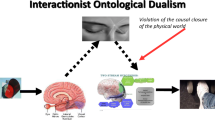Abstract
Based on the technique ofpressure blinding of the eye, two types of after-image (AI) were identified. A physicalist or mind/brain identity explanation was established for a negative a AI produced by moderately intense stimuli. These AI's were shown to be located in the neurons of the retina. An illusory AI of double a grating's spatial frequency was also produced in the same structure and was both prevented from being established and abolished after establishment by pressure blinding, thus showing that the location was not more central. The illusory AI was predicted from the knownnon-linearity in the retina and this is the first case of a clear cut type-type identity of a sensation and a neural process. Some implications for the concepts of the explanatory gap between neurology and consciousness and multiple neural realizations of conscious states and topic neutrality are discussed.
Similar content being viewed by others
REFERENCES
Anstis, S., B. Rogers, and J. Henry: 1978, ‘Interactions between Simultaneous Contrast and Coloured Afterimages', Vision Research 18, 899–911.
Armstrong, D. M.: 1968, A Materialist Theory of Mind, Routledge and Kegan Paul, London.
Armstrong. D. M.: 1980, The Nature of Mind, University of Queensland Press, Brisbane.
Armstrong, D. M. and N. Malcolm: 1984, Consciousness and Causality: A Debate on the Nature of Mind, Blackwell, Oxford.
Bechtel, W. and J. Mundale: 1999, ‘Multiple Realizability Revisited: Linking Cognitive and Neural States', Philosophy of Science 66, 175–207.
Bigelow, J., J. Collins, and R. Pargetter: 1990, ‘Colouring in the World', Mind 99, 279–288.
Block, N. and J. Fodor: 1980, ‘What Psychological States are Not', in N. Block (ed.), Readings in Philosophy of Psychology, Vol. 1. Harvard University Press, Cambridge, MA, pp. 237–250.
Boghossian, P. A. and J. D. Velleman: 1989, ‘Colour as a Secondary Quality', Mind 98, 81–103.
Borst, C. V.: 1970, The Mind/Brain Identity Theory, St.Martin's Press, London.
Bradley, M. C.: 1964, ‘Critical Notice: Philosophy and Scientific Realism', in J. J. C. Smart (ed.), Australasian Journal of Philosophy XLI, 262–283.
Braddon-Mitchell, D. and F. C. Jackson: 1996, The Philosophy of Mind and Cognition, Blackwell, Oxford.
Brown, K. T.: 1968, ‘The Elecroretinogram: It's Components and their Origins', Vision Research 8, 633–677.
Chalmers, D. J.: 1996, The Conscious Mind, Oxford Univesity Press, Oxford.
Craik, K. J. W.: 1940, ‘Origin of Visual After-images', Nature 145, 512.
Craik, K. J. W. and M. D. Vernon: 1941, ‘The Nature of Dark Adaptation', British Journal of Psychology 32, 62–81.
Day, R. H. and W. R. Webster: 1989, ‘Negative Afterimages and the McCollough Effect', Perception and Psychophysics 46, 419–424.
Fodor, J.: 1997, ‘Special Sciences: Still Autonomous after all these Years', Philosophical Perspectives 11, 149–163.
Heil, J.: 1999, ‘Multiple Realizability', American Philosophical Quarterly 36, 191–208.
Jackson, F. C.: 1977, Perception, Cambridge University Press, Cambridge.
Jackson, F. C. and P. Pettit: 1990, ‘Causation in the Philosophy of Mind', Philosophy and Phenomonological Research L, 195–214.
Kim, J.: 1993, Supervenience and Mind, Cambridge University Press, Cambridge.
Levine, J.: 1983, ‘Materialism and Qualia: the Explanatory Gap', Pacific Philosophical Quarterly 64, 354–361.
Levine, J.: 1994, ‘On Leaving out What it's Like', in M. Davies and G. W. Humphreys (eds.), Consciousness, Blackwell, Oxford, pp. 121–136.
Lycan, W. G.: 1987, Consciousness, The MIT Press, Cambridge, MA.
Macdonald, C.: 1992, Mind-Body Identity Theories, Routledge, New York.
Malsburg, Von der C.: 1995, ‘Binding in Models of Perception and Brain Function', Current Opinion in Neurobiology 5, 520–526.
Nagel, T.: 1998, ‘Conceiving the Impossible and the Mind-body Problem', Philosophy 73, 337–352.
Place, U. T.: 1956, ‘Is Consciousness a Brain Process?', British Journal of Psychology XLVII, 44–50.
Place, U. T.: 1970, ‘Is Consciousness a Brain Process?', in C. V. Borst (ed.), The Mind/Brain Identity Theory, St. Martin's Press, London, pp. 42–51.
Putnam, H.: 1980, ‘The Nature of Mental States', in N. Block (ed.), Readings in Philosophy of Psychology, Volume One. Harvard University Press, Cambridge, MA., pp. 223–231.
Rorty, R.: 1970, ‘Mind-body Identity, Privacy and Categories', in C. V. Borst (ed.), The Mind/Brain Identity Theory, St. Martin's Press, London, pp. 187–213.
Rosenthal, D. M.: 1976, ‘Mentality and Neutrality', Journal of Philosophy LXXIII, 386–415.
Shaffer, J.: 1970, ‘Could Mental States be Brain Processes?', in C. V. Borst (ed.), The Mind/Brain Identity Theory, St. Martin's Press, London, pp. 113–122.
Sherrington, C.: 1947, The Integrative Action of the Nervous System, Cambridge University Press, Cambridge.
Singer, W. and C. M. Gray: 1995, ‘Visual Feature Integration and the Temporal Correlation Hypothesis', Annual Review of Neuroscience 18, 555–586.
Smart. J. J. C.: 1959, ‘Sensations and Brain Processes', Philosophical Review LXVIII, 141–156.
Smart, J. J. C.: 1995, ‘“Looks Red” and Dangerous Talk', Philosophy 70, 545–554.
Stufflebeam, R. S. and Bechtel, W.: 1997, ‘PET: Exploring the Myth and the Method', Philosophy of Science 64, S95–S106.
Taylor, C.: 1970, ‘Mind-body Identity, a Side Issue?', in C. V. Borst (ed.), The Mind/Brain Identity Theory, St. Martin's Press, London, pp. 231–241.
Treisman, A.: 1996, ‘The Binding Problem', Current Opinion in Neurobiology 6, 171–178.
Van Orden, G. C. and K. R. Paap: 1997, ‘Functional Neuroimages Fail to Discover Pieces of Mind in the Parts of the Brain', Philosophy of Science 64, S85–S94.
Virsu, V. and P. Laurinen: 1977, ‘Long-lasting Afterimages Caused by Neural Adaptation', Vision Research 17, 853–860.
Weiskrantz, L.: 1986, Blindsight: A Case Study and Implications, Oxford University Press, Oxford.
Author information
Authors and Affiliations
Rights and permissions
About this article
Cite this article
Webster, W.R. A Case of Mind/Brain Identity: One Small Bridge for the Explanatory Gap. Synthese 131, 275–287 (2002). https://doi.org/10.1023/A:1015726204005
Issue Date:
DOI: https://doi.org/10.1023/A:1015726204005




